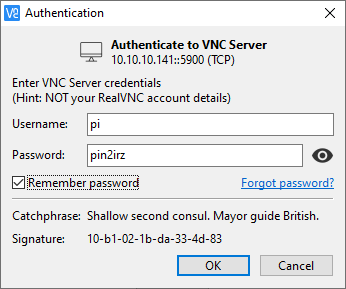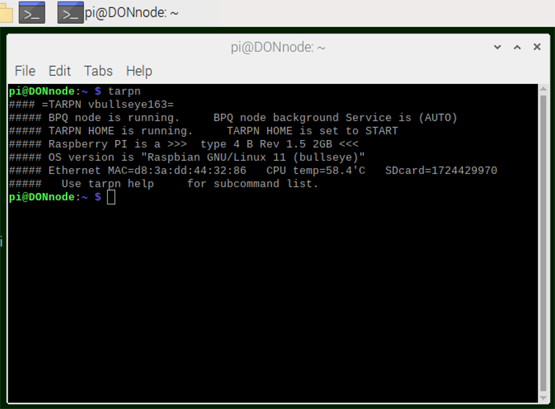
Interacting with your TARPN NodeOnce you have a TARPN node configured and running, you’ll want to play with it. One way it to access the node desktop directly to use QTTerm and the Terminal window, using VNC. A second way is to access the node using TARPN Home. I recommend BOTH, since they each serve their own purposes. Typically, we interact directly with the Pi using VNC to run commands for the operating system, TARPN commands (like TARPN STRESSTEST), and monitor node traffic. More often, we are in the Chat and BBS, accessed through TARPN Home, using any device that supports a web browser. While it works with small screens, it is not optimized – use a tablet, laptop or desktop instead. What you really don’t want to do is to use the BBS and CHAT commands directly in the node. These do function, and while users of previous G8BPQ networks may think this is a good way to do these things, new ways are far better. Step 1: VNC VNC is a utility used to access remote computers, and it works well with Raspberry Pi and your TARPN Node. Using VNC, you no longer need monitor/keyboard/mouse connected to the node, everything runs over WiFi or Ethernet. This is useful for accessing the terminal window (to issue TARPN commands, for example) and QTTerm for interacting with and monitoring the node. If you’ve set up the node following the instructions at Set up Pi as a TARPN Node then the VNC Server on the Pi is ready for you. This assumes you also enabled and activated WiFi access for the node OR have it wired in via Ethernet. On your device (such as a Windows computer, phone, tablet, etc.) download a VNC Client App (I use “VNC Viewer” on Windows and RealVNC on iOS, but there are several) and install it. Configure a New Connection and fill in at least the VNC Server (Raspberry Pi) IP address. Optionally, give the connection a friendly name (like “Don’s Node”). Open the connection and log in to the Pi with the user ID (pi) and password you chose when making the microSD Card. Select the option to remember the password (if it exists). 
VNC Client will open to the Pi’s desktop. From here, you can control the Raspberry Pi just as if you were using a directly-connected monitor/keyboard/mouse. Step 2: QTTerm This TCP terminal for G8BPQ connects to your node and allows the use of node commands and monitoring of the traffic passing in and out of the node. Follow the instructions at TARPN Builders - QTTerm to load, configure and open QTTerm. The top window is the monitor, the bottom window is the responses from the node commands typed into the line at the bottom. I usually leave QTTerm open all the time at maximum size to monitor TX, Supervisory, Node Broadcasts and all radio ports. Step 3: Terminal window This is how you issue commands to your node, including for TARPN. Click the icon on the top menu to open a Terminal window. Multiple windows may be open at the same time. 
I usually leave one Terminal window open all the time Step 4: TARPN Home TARPN Home is a web server on your Node that lets you use the advanced CHAT interface, interact with the node (like the bottom window in QTTerm), provides a nice access to the BBS and offers some node performance data. Follow the instructions at TARPN Builders - Home Web Application, as well as configuring the BBS as explained at TARPN Builders - BBS Configuration and setting up Chat as explained at TARPN Builders - Configure Chat TroubleshootingVNC: Low-resolution Desktop If the VNC image resolution isn’t OK, you can adjust that under ‘Headless Resolution” (click Menu > Preferences > Raspberry Pi Configuration > Display tab > Headless Resolution). The Pi may need a reboot. Some users find this setting displays 600 x 800 regardless of the configuration. While the cause is not yet understood, the only cure found so far is to re-build your node from scratch by re-imaging the microSD card. VNC: Monitored text in black QTTerm can be configured to monitor node text, displaying transmited frames in red and received frames in blue. If this shows up only as black & white, open QTTerm and set the Colour option before doing anything else. Once you’ve connected to the node the option disappears. VNC: Not everything is monitored Check the settings under the Monitored tab once connected. Sometimes the checkboxes uncheak themselves for some unknown reason. Or if you have checked "Monitor only UI frames" nothing else will appear. |
For the huge majority of things not covered here, visit the TARPN Home Page, especially the Builder's section |
This website is maintained by Don Rotolo, N2IRZ. Contact me via the information on QRZ.COM
Updated 12SEP2024